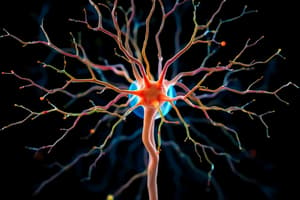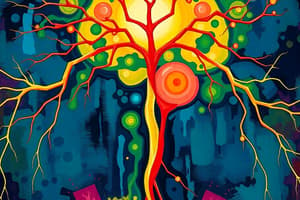Podcast
Questions and Answers
Match the following terms with their correct definitions:
Match the following terms with their correct definitions:
Synapse = Junction between two neurons Afferent = Carrying impulses toward the CNS Myelin = Fatty substance that insulates axons Reflex = Involuntary response to a stimulus Efferent = Carrying impulses away from the CNS
Match the following structures with their roles in the nervous system:
Match the following structures with their roles in the nervous system:
Somatic nervous system = Controls voluntary movements Autonomic nervous system = Regulates involuntary activities Sensory neurons = Transmit signals from receptors to the CNS Motor neurons = Transmit signals from the CNS to effectors
Match the following brain parts with their primary functions:
Match the following brain parts with their primary functions:
Cerebrum = Responsible for higher functions such as thought and action Brainstem = Controls basic life functions like breathing and heart rate Diencephalon = Processes sensory information and regulates homeostasis Cerebellum = Coordinates movement and balance
Match the following medical conditions with their likely symptoms:
Match the following medical conditions with their likely symptoms:
Match the following components of the nervous system with their corresponding types:
Match the following components of the nervous system with their corresponding types:
Match the following types of neurons with their primary functions:
Match the following types of neurons with their primary functions:
Match the following components of the neuron with their descriptions:
Match the following components of the neuron with their descriptions:
Match the following parts of the nervous system with their classification:
Match the following parts of the nervous system with their classification:
Match the following medical terminology with their meanings:
Match the following medical terminology with their meanings:
Match the following terms with their related functions in the nervous system:
Match the following terms with their related functions in the nervous system:
Match the following anatomical terms with their corresponding types:
Match the following anatomical terms with their corresponding types:
Match the following terms with their clinical significance:
Match the following terms with their clinical significance:
Match the following terms with their definitions:
Match the following terms with their definitions:
Match the following brain structures with their primary functions:
Match the following brain structures with their primary functions:
Match the following medical terms with their meanings:
Match the following medical terms with their meanings:
Match the following conditions with their descriptions:
Match the following conditions with their descriptions:
Match the following types of fluid or substances with their functions:
Match the following types of fluid or substances with their functions:
Match the following psychiatric disorders with their descriptions:
Match the following psychiatric disorders with their descriptions:
Match the following diagnostic tools with their functions:
Match the following diagnostic tools with their functions:
Match the following prefixes/suffixes with their meanings:
Match the following prefixes/suffixes with their meanings:
Match the following types of nerves with their functions:
Match the following types of nerves with their functions:
Match the following terms with their related components:
Match the following terms with their related components:
Study Notes
Nervous System Overview
- The nervous system is responsible for coordinating body functions through signals.
- It's divided into the central nervous system (CNS) - brain and spinal cord - and the peripheral nervous system (PNS).
- The PNS is further divided into the somatic nervous system controlling voluntary actions and the autonomic nervous system regulating involuntary actions.
The Neuron
- The neuron is the basic unit of the nervous system.
- It consists of a cell body, dendrites, and an axon.
- Dendrites transmit signals towards the cell body, while axons transmit signals away.
- Myelin, a fatty substance, covers some axons, speeding up signal transmission.
- Myelinated axons form white matter, while unmyelinated axons form gray matter.
- Sensory neurons send signals to the CNS, while motor neurons send signals away from the CNS.
- A synapse is the connection point between two neurons, where signals are transmitted using neurotransmitters.
Nerves
- Nerves are bundles of neuron fibers found in the PNS.
- Ganglions are collections of neuron cell bodies along nerve pathways.
- Some nerves carry only sensory or motor signals, while most are mixed nerves carrying both types.
Brain and Spinal Cord
- Brain:
- Cerebrum: Responsible for memory and reasoning
- Diencephalon: Acts as a sensory relay and controls hormone production
- Brainstem: Regulates vital functions
- Cerebellum: Coordinates movement and balance
- Spinal Cord:
- Extends from the brainstem to the lower back.
- Connects to 31 pairs of nerves for sensory and motor control.
Autonomic Nervous System
- Controls involuntary functions like heart rate, digestion, and breathing.
Terminology
- afferent: Sensory neurons and nerves that carry signals towards the CNS.
- efferent: Motor neurons and nerves that carry signals away from the CNS.
- autonomic nervous system: Regulates involuntary activities.
- central nervous system: Brain and spinal cord.
- cerebrospinal fluid: Protects the brain and spinal cord.
- synapse: Junction between two neurons.
- reflex: An automatic, rapid response to a stimulus.
- neurotransmitter: Chemical responsible for transmitting signals across synapses.
- gli/o: Refers to neuroglia, supporting cells in the nervous system.
- gangli/o: Refers to ganglia, collections of neuron cell bodies.
- mening/o: Refers to meninges, membranes covering the brain and spinal cord.
- encephal/o: Refers to the brain.
- narc/o: Refers to stupor or unconsciousness.
- -phobia: Refers to a persistent, irrational fear.
Related Terms
- Amyloid: Substance that accumulates in the brain in diseases like Alzheimer's.
- Coma: Deep unconsciousness.
- Concussion: Brain injury caused by impact.
- Convulsion: Series of involuntary muscle contractions.
- Dementia: Gradual and irreversible loss of cognitive function.
- Encephalitis: Inflammation of the brain.
- Epilepsy: Disorder characterized by seizures.
- Parkinsonism: Disorder affecting the basal ganglia, resulting in movement issues.
- Paralysis: Loss of function, movement, or reflexes.
- Alzheimer disease: Form of dementia.
- Tremor: Shaking movement.
- Anxiety: Feeling of fear, worry, or uneasiness.
- Schizophrenia: Severe mental disorder characterized by psychosis and hallucinations.
- Depression: Mental state characterized by sadness, hopelessness, and lack of interest.
Diagnostics and Treatment Terms
- Electroencephalography (EEG): Records and analyzes brain electrical activity.
- Cerebral angiography: Radiographic study of brain blood vessels using contrast medium.
Case Study Questions
- Diagnosis: The most likely diagnosis is a stroke.
- Nervous System Affected: The central nervous system is primarily affected.
Studying That Suits You
Use AI to generate personalized quizzes and flashcards to suit your learning preferences.
Related Documents
Description
This quiz provides an in-depth overview of the nervous system, highlighting its structure and functions. It explores the roles of the central and peripheral nervous systems, the anatomy and function of neurons, and the process of signal transmission. Test your knowledge on how the nervous system coordinates body functions and the intricacies of neuronal communication.




